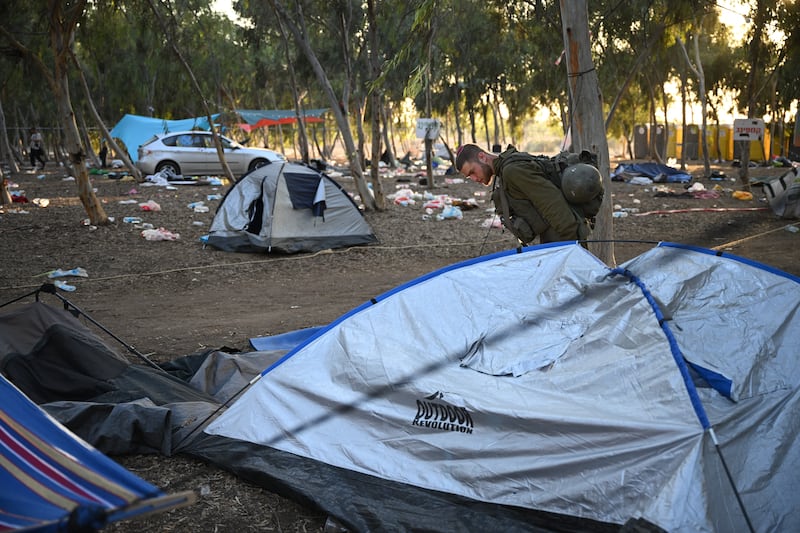The capabilities displayed by Israeli intelligence and the Israel Defence Forces (IDF) over the last few weeks, from the pager and walkie-talkie attacks in Lebanon to the pinpoint assassinations that killed Hizbullah leader Hassan Nasrallah, have gone a long way to restore the deterrence-effect that was so badly damaged on October 7th when Hamas militants from Gaza stormed across the border into southern Israel, facing scant resistance.
As Israelis gather to mark the one-year anniversary of the 1,200 people killed on October 7th, most of them civilians, and remember the hostages who were seized and taken to Gaza, questions remain how an army with such capabilities was caught off-guard.
Hamas planned the attack for years and Israel knew the militant group had smuggled huge quantities of weapons into Gaza via Egypt and had built a vast tunnel network. The intelligence community received numerous indications in the lead-up to the invasion but these were all ignored because a misconception had taken hold that Hamas was “deterred” and had no intention of attacking Israel.
[ Kibbutz Be’eri: ‘October 7th ended the dream of coexistence forever’Opens in new window ]
Speaking on October 1st, 2023, Israel’s national security adviser Tzachi Hanegbi noted that for the previous two years Hamas had not initiated any rocket launches and had reduced the level of violence in an “unprecedented” manner. “Hamas is very restrained, and understands the meaning of further defiance,” he said, less than a week before the attack.
RM Block
The Israeli leadership believed that although Hamas was steeped in the Jihadist ideology of the Muslim Brotherhood, its time in power in Gaza had a moderating influence and it was focused on attending to the day-to-day needs of the more than two million Gaza residents.

Huge amounts of cash from Qatar was flowing into Gaza and some 18,000 Gazans crossed into Israel every day to work, earning a salary 10 times higher than that on offer in the impoverished coastal enclave. Israel believed that these economic incentives had deterred Hamas from initiating another round of violence.
Combined with this was the impressive state-of-the-art border defences put in place, at a cost of billions of euro. Construction of a 48m underground wall was completed in 2021 to combat the threat of Hamas’s cross-border attack tunnels. Sophisticated electronic sensors and cameras warned of anyone approaching the fence, and remotely operated machine guns in concrete towers along the border were ready to deal with an above-ground threat. It was believed that the border was impregnable.
The Hamas leadership played along with the Israeli misconception, all the while building up its military strength and planning for the deadly invasion which would be on an entirely different level to any of the previous rounds of violence with Israel.
The number of troops along the border was gradually reduced and even the small security detachments in border communities were ordered to keep their weapons locked up in a secure room to prevent theft.
A bigger deployment of Israeli soldiers along the border could have prevented the advance of the Hamas forces after the incursion but, in the weeks leading up to October 7th, serious unrest in the West Bank led the army to transfer forces from the Gaza periphery.
On the morning of October 7th, there were approximately 25 IDF combat battalions in the West Bank and fewer than four – some 600 soldiers – along the entire Gaza border. Two elite commando companies of more than 100 soldiers had been transferred to the West Bank on October 5th.
Some 3,000 Hamas fighters used bulldozers and explosives to breach the fence at 30 locations, while drones destroyed Israel’s border cameras, all under the cover of a massive mortar barrage.
Over the years, IDF spotters had monitored and reported on Hamas exercises simulating breaching the border fence and invading Israel, but these warnings were ignored. Hamas had even produced a television programme showing what a cross-border attack would look like, including the capture of hostages from Israeli communities.
In the hours preceding the attack, Israeli intelligence received information that Hamas operatives had switched their mobile phone sim cards to Israeli sim cards, but again the information was ignored.
Thousands of Hamas fighters had trained to take part in the operation but, to avoid leaks, they were only informed during early prayers in the mosques at 4am on the morning of the attack. The Hamas leadership in Gaza also deliberately failed to inform the group’s leadership abroad, and its Hizbullah and Iranian allies, about the timing of the attack.
[ US charges Hamas leaders over October 7th attack on IsraelOpens in new window ]
Israel’s intelligence community had enough real-time warning signs but failed to join the dots. The intelligence disaster was almost identical to the 1973 Yom Kippur war. Back then, clear warnings that Egypt was about to attack were ignored because it was believed Egyptian president Anwar Sadat wasn’t interested in war. The events of October 7th occurred 50 years and one day after the start of the Yom Kippur war.
Once the invasion was under way, the response of the army was woefully inadequate and the besieged communities were left to defend themselves for many hours until reinforcements arrived. There was simply no plan in place for such a scenario. Former national security adviser Yaakov Amidror noted: “The army does not prepare itself for things it thinks are impossible.”
The top priority for the Hamas invaders was the IDF’s Gaza division base at Re’im, close to the border. Once that was conquered, the army had difficulty assessing the overall situation and allocating reinforcements in real time. Chaos ensued as the entire command structure responsible for co-ordinating all military activity in the region failed to function. Many soldiers and civilians with weapons headed south of their own volition and ad-hoc units formed to help rescue the communities under attack. But Hamas controlled the approach roads and set up deadly ambushes.
Prime minister Binyamin Netanyahu has resisted calls for a state commission of inquiry – an independent body with broad powers – to address the failures that led to October 7th, fearing such a body will point the finger of blame at him. He maintains that everything can be examined – including his own role – once the fighting is over. His critics argue that part of his motivation for keeping Israel at war is to delay such an investigation. To this day, Netanyahu remains the only senior figure in the political, military and intelligence echelons who has refused to admit personal responsibility.
Maj Gen Aharon Haliva, who was the commander of the IDF’s military intelligence, was the first general to accept responsibility and resign earlier this year. “The military intelligence directorate, under my command, failed to warn of the terror attack carried out by Hamas,” he said. “We failed in our most important mission. I carry that black day with me ever since, day after day, night after night. I will carry the horrible pain of the war with me forever.”
Former IDF chief of staff Gadi Eisenkot, who joined the war cabinet after the Hamas attack, said everyone in a position of leadership needed to step down.
“The failure is so great that none of them can stay in office,” he said.
- Listen to our Inside Politics Podcast for the latest analysis and chat
- Sign up for push alerts and have the best news, analysis and comment delivered directly to your phone
- Find The Irish Times on WhatsApp and stay up to date
















